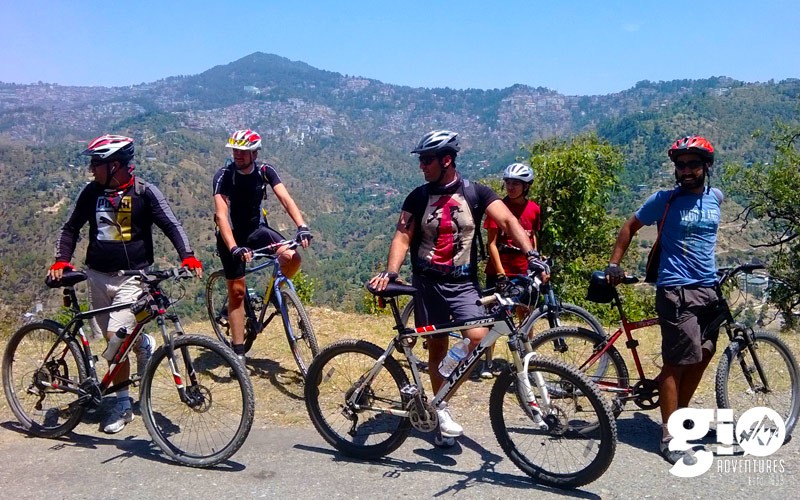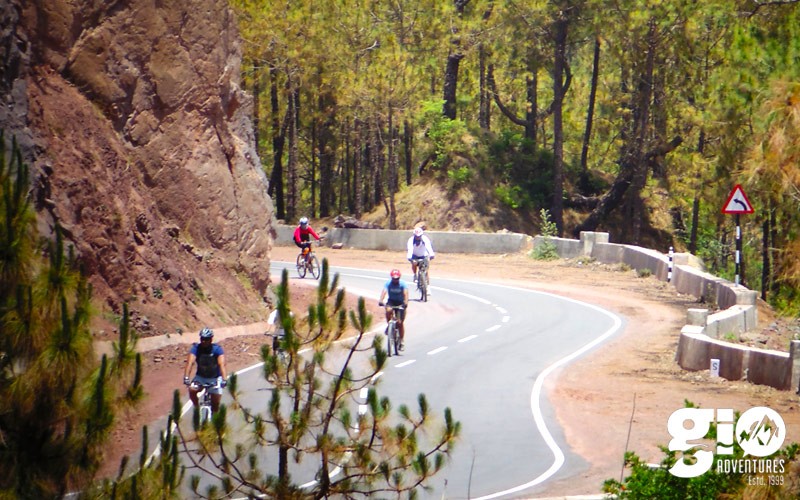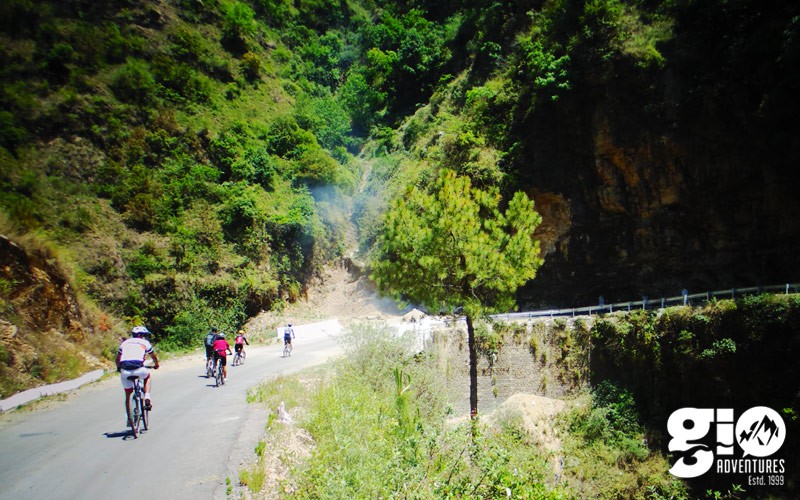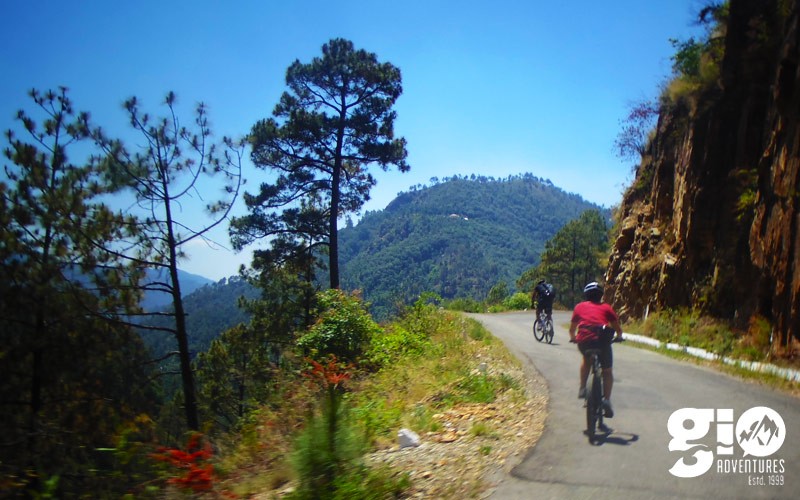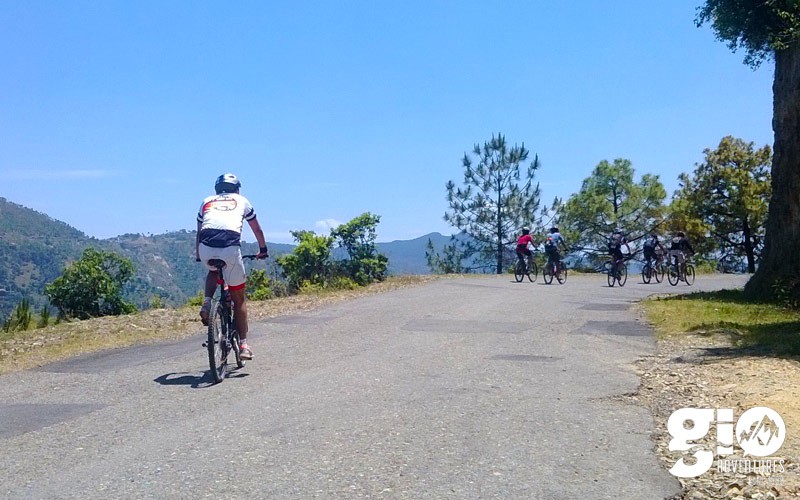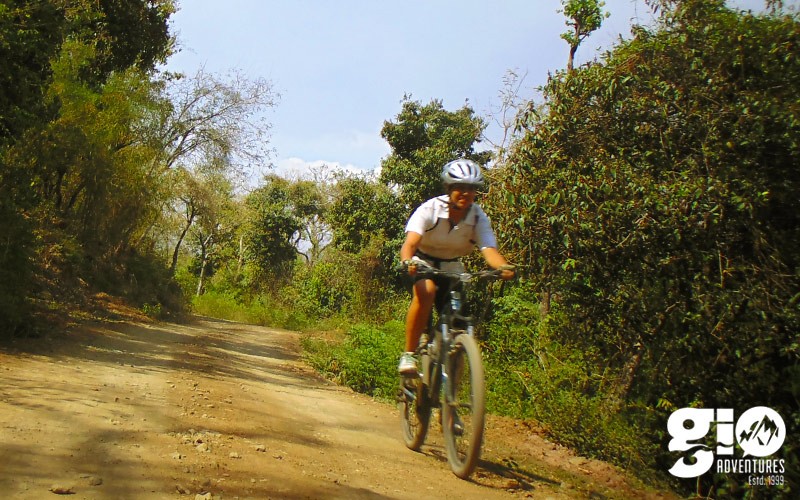- +91-7895979211, 7895979208
- LOGIN

CYCLING: SHIMLA TO CHANDIGARH
- Region - Uttarakhand
- Base Camp - Shimla
- Duration 2 Days
- Altitute 2800m
- Stay Rooms
- Difficulty Easy
Detail itinenary
We arrive at Shimla early morning at 6:00 AM and check into Camp Redwoods. After freshening up and a quick breakfast at 8:00AM we will depart for the ride start at 9:00 AM to start the ride at 9:30AM. The first stage of today’s course is 18 kms of rolling terrain on a tarmac surface. The second stage is part offroad and part tarmac, 27kms downhill with uphills interspersed. The last stage of the day is another 23 kms after which we finish the ride just before Kasauli and are transported to the Hotel in our support Jeep.
After an early morning breakfast at 7:00AM, the ride starts at 8:00Am following the backcountry roads leading us to Kumarhatti, a quaint junction on NH22. From here a fantastic tarmac surfaced road will lead us to Sukkhi Jodhi. The third stage of the day is a 27 kms downhill on gravel towards Mallah, reaching the the great Shivalik plains. Here we enter the Morni hills reserved forest and ride another 7 kms towards Amrapali on the main highway. We have the option of boarding the support vehicle here or riding further still Chandigarh, terminating the ride at Sukhna Lake. After a small celebration and snacks at the Lake, you could continue ahead towards your onward destination.
Trip Detail
This Season, in the golden glow of the Himalayan autumn, we invite mountain bikers from across the country, to gear up and pedal this historic route. The idea is to enjoy the outdoors as we ride through forest trails on the vestiges of the Kalka Shimla highway and soak in the beauty of the Shivalik Hills. An outdoor trip is never complete without staring at the stars and wide open skies. We are keeping the route a little secret, a surprise for you to come and explore.
Day two of our riding we have reached the lower foothills of shivaliks, almost the great Indian plains. Come to enjoy the cool breeze and ride a trail that is seeped in history, nature and camaraderie.
History of Shimla goes back to the period of Anglo-Gurkha war in the beginning of 19th century. In 1804 the Gurkhas , who had suffered a severe defeat at the hands of the Sikhs at the battle of Kangra, a hill fortress about sixty miles from Shimla, where according to some accounts they lost thousand of men in the fight and many others from disease, commenced to ravage the states and hills surrounding Shimla. Gurkhas built many forts around Shimla. One of these strongholds, the Jagatgarh fortress, was the origin of the modern Jutogh, the well known military cantonment adjoining Shimla. By 1808 the invaders had conquered all the fortified posts between the Jamuna and Satluj, and from their capital Arki began their ruthless rule over the neighbouring hill states, untill at length the people in their wretchedness appealed to the British for help. A small British force under Major General 'Sir David Ochterlony' was despatched to liberate the hill men from Gurkhas. Majority of hill chiefs responded to the call and joined the British forces.
The rivals were engaged in the toughest battle at 3750 ft high Ramgarh fort at Nalagarh. A decisive battle took place near the fort at Malaon in which superior guns of the British overpowered the enemy. The battle of Malaon on 15th May 1815 ended the dream of the Gurkhas, to rule over this part of the land for any longer. After few days, an official declaration was made according to which all Chieftains who had joined British in expelling the Gurkhas were restored with their land under the British protection. The maharaja of Patiala who has also rendered invaluable services to the British was rewarded with land in the neighbourhood of the area now comprising Shimla. After the defeat of Gurkhas they were forced to sign the 'Treaty of Sanjauli' .
The company retained the strategic forts of Sabathu, Kotgarh, Ramgarh and Sandoch. Shimla is the Capital Town of Himachal Pradesh. It was formerly the summer capital during the British Rule. The town of Shimla is built over several hills and connecting ridges. The important hills are Jakhu(8050 ft), Prospect Hill (7140 ft), Observatory Hill ( 7050 ft), Elysium Hill (7400 ft), and Summer Hill (6900 ft)
There is a great controversy over the origin of the name Shimla. The name Shimla was derived from 'Shyamalaya' meaning blue house said to be the name of house built of blue slate by a faqir on Jakhu. According to one version Shimla takes it name from 'Shamla' meaning a blue female another name for Goddess Kali. The place was on the Jakhu Hillside, there was a temple of Goddess Kali. During the British period the image of the Goddess was shifted to a new place ,now famous Kali Bari Temple.
Shimla remained unnoticed during the Gurkha War. It was only in 1819 A.D. that the then Assistant Political Agent of hill states Lt. Ross set up first British residence, a mere wood cottage. His successor Lt. Charles Patt Kennedy' errected the first pucca house in 1822 named after Lt. Kennedy as 'Kennedy House'.
The construction of Hindustan Tibet road was started in 1850-51 commencing from Kalka and first lap was upto Shimla. The Road upto Shimla came to be used for wheeled traffic by 1860. A 560 feet long tunnel was constructed beyond Sanjauli.
The idea is to enjoy the outdoors as we ride through forest trails on the vestiges of the Kalka Shimla highway and soak in the beauty of the Shivalik Hills. An outdoor trip is never complete without staring at the stars and wide open skies. After a day of riding on October 5th we reach Gamberpul, one of the earliest bridges built by the british. After a quick after ride snack we are transported to Kasauli to the comfort of our rooms.
The riding is about 70 kms on this day. We are keeping the route a little secret, a surprise for you to come and explore. Day two of our riding we have reached the lower foothills of shivaliks, almost the great Indian plains, however just before we disembark to Chandigarh, a nice backcountry road will take us to the base of Morni hills from where we descend to Chandigarh.
BIKE RENTAL (FOR 2 DAYS) - RS. 1200/-
Merida Matts – 21 speed, Hardtail bike with Helmet.
Price Info
- Accommodation of your preference (Single Or Double Sharing Bases) at a hotel in Kasauli, Breakfast on day one at H.E.L Camp Redwoods, Shimla, Hot lunch on day one and two, Dinner on day one at Kasauli, Evening snacks, Ride nutrition (Dry fruit pack, bananas, Gatorade, Chocolates) Ride Mechanic, GST Tax
- Transport from Delhi to Shimla and from Chandigarh to Delhi, Any personal expenses (Tips, Medicines etc), Insurance, Any expenses raised due to natural occurrences, Cost of spare parts.
Departure Dates
Departure Dates
Reviews
PAYMENT TERMS & CONDITIONS
- All payments for the trips, transfers, porterage, etc. should be made in full before the trip starts.
- Cancellation Policy: In the event that you need to cancel your booking due to any avoidable or unavoidable circumstances:
- We must be notified of the same in writing. Cancellation charges will be effective from the date we receive the request in writing. Any cancellation sent on a Sunday or any National Holiday(s), will be considered on the next official working day.
- Payment for this trip will not be adjusted towards any future trip(s)
- In the event of any cancellation(s) after trip commencement, there will be no refunds and any costs incurred due to this cancellation will be borne by you.
- Irrespective of when a trip is booked, the above condition will hold true
- Cancellation charges will be as follows
- >45 Days: Full refund (after deducting any expenses that have been incurred for hotel bookings, transport, etc.)
- 30-45 Days: 75% of trip cost will be refunded (after deducting any expenses that have been incurred for hotel bookings, transport, etc.)
- 15-30 Days: 50% of trip cost will be refunded (after deducting any expenses that have been incurred for hotel bookings, transport, etc.)
- <15 Days: No refund
VITAL INFORMATION
WEATHER DETAILS
This snow trek is organized between Dec & mid-March when the region has had good snowfall. Contrary to the popular belief winters is a good time to be in the mountains if one is equipped properly. Most locals inhabiting higher reaches of the mountains don’t mind the problems associated with snowfall and seem to have a good time during these months. Also there are lots of local festivals in these months. In these months weather is generally clear most of the days. Day time is normally pleasantly warm with one getting to enjoy sitting out in the sun. Temperature would be around 12-17 °C. Evenings are quite cold and one would need to be inside a tent/room or sitting outside next to fire with proper winter clothes. The evening temperatures will be around – 3 to 5 °C. Nights can be very cold with temperatures in the range of – 8 to 0 °C.
Please keep in mind that the above information is not exact and does not account for sudden changes. Whatever the temperatures and conditions rest assured we will be prepared to handle it with ease as we use equipment of very high specifications.
LIST OF ESSENTIALS
It is very important for this adventure trip that you need to be equipped properly and with a bit of back up. Mountain/adventure travel requires one to be adequately equipped with the right kind of personal gear. Since one is travelling in the wilderness there will be hardly any opportunity to buy anything once you hit the trail so we urge you to carefully pack everything into your bags.
- T-shirts (Full) – 2/3
- Warm shirt/light micro fleece pullover/full sleeve T shirt
- Trekking Pants (water resistant/repellent & having inside lining for extra warmth) - 2
- Windproof/water resistant outer shell (jacket) of good quality (no flimsy wind cheaters please!) with a proper hood
- Down jacket with min 600 fill power rating
- Thick Fleece / Full-sleeve Woollen sweater
- Thermal inner wear (upper & lower)
- Woollen cap (Balaclava)
- Inner fleece gloves
- Outer water proof gloves
- Thick woollen socks & regular socks (4 – 5 pairs)
- Scarf/muffler (optional)
- Comfortable waterproof (Goretex) Trekking/Hiking shoes (shoes with a thick sole and high ankles are recommended)
- Camp shoes (these can be easy to slip in sneakers/sport shoes)
- Gaiters
- Raincoat / Poncho
- Small light weight towel
- Insulated water bottle & hydration pack (optional)
- Cap / floppy hat to keep the strong sun away from your face
- Sun glasses with UV protection and ability to cut the glare (imp when traversing through snow)
- Sturdy walking stick / Trekking pole
- Sunscreen Lotion
- Lip Balm
- Torch / Flashlight (with extra batteries)
- Medicines, if requiring any specific medication
- Personal toiletries
- Book, if you like reading
- Day pack/small bag which you will carry on your back every day and keep your essentials in it
- Carry rain cover for your bags
- Keep a few poly bags or waterproof bags in your bag in which if required you can put your belongings in case of heavy rain
- Camera if you like (with fully charged batteries)
- …LOADS OF ENTHUSIASM!! AND A PLEDGE TO LEAVE NO TRACE
Carry your stuff in a duffel bag, soft shoulder bag or a rucksack. Avoid suitcases, trolleys or any other hard luggage. As you will be walking long distances carrying a rucksack, avoid bringing unnecessary items on the trek. Please avoid carrying expensive watches, jewellery and electronic items on the trek.
NOTE: In case you are planning to put your bag on a mule or taking a porter please get a duffel bag or rucksack and keep it in mind that there is a possibility that the bag at times might brush against a rock or a tree and get slightly damaged so don't get very expensive bags. Also in case of damage we shall not be held accountable.
TRANSPORT OPTIONS (DELHI – DEHRADUN – DELHI)
For travel to Dehradun/Haridwar/Haridwar, one can choose between air, rail & road. For air travel, the closest airport is the Jolly Grant Airport (Dehradun) and is well connected to Delhi and other parts of the country by Air India, Jet Airways, GoAir & Spice Jet. Train travel is highly recommended with enough options being there. For train details, you could log on to www.indianrail.gov.in and for online railway ticket bookings you could log on to www.irctc.co.in.
There are frequent Public Transport buses including Volvos available from Delhi to Dehradun that cost about Rs. 300 - 800 per person. These buses depart from Delhi ISBT every 30 mins to 1 hr or so and take about 4/5 hrs to cover the distance. The same is also applicable on the return journey. A private vehicle could also be arranged for if you require the same.
OUR TREKKING CODE
We are mountain lovers and have pledged to bring no harm to them in our pursuit of running organised wilderness travel in the Himalayas and seek your assistance too in this regard. We are more than convinced that one can have more fun on a trip if we go about it in a way that no harm is caused to the ecology. In this regard we have a set of guidelines that we adhere to based on the tenets of 'Leave No Trace' & 'Tread Light' policies. These guidelines are very simple and emphasise on travelling in small groups, better planning, understanding impact of camping, proper waste disposal, respecting local cultures, sensitivity towards wildlife and so on. We have a complete section on our trekking code in the 'GIO trekking Manual'. This manual will be couriered to you once you confirm a trip with us.
ACCLIMATISATION & HIGH ALTITUDE SICKNESS
This is one of the most important aspects of traveling in the high Himalayas and cannot be ignored or set aside. Acclimatization basically means our body adjusting to lower levels of oxygen (rarefied air) & reduced air pressure as me move up. In case one does not acclimatize properly there are chances of the person facing extreme discomfort and this can be fatal in extreme cases. While there is no set route to getting properly acclimatized there are general precautions and steps that one can take to initiate good acclimatization. Our trekking guides will assist you with these steps and also once you book a trip with us the 'GIO Trekking Manual' which will cover this aspect extensively will be couriered to you. This is sure to help you enjoy the trek in very good shape.
SELECTING THE RIGHT TREK & TRAINING FOR IT
Most important thing is to select the right trek keeping in mind your experience or inexperience, health, objectives & ability. Our senior team people can assist you with this, so when contacting us do mention if you need guidance on this front also refer to our trek grading system mentioned below. Once the right trek is selected comes your preparation. Once you have booked a trip with us we will courier the 'GIO Trekking Manual' to you which will have a complete practice drill explained in detail.
TREK GRADING SYSTEM
We have broadly classified our treks as below:
Easy: These treks are 3 to 5 days long and involve walking for about 3/4 hrs daily. The trail on such treks is well defined but not always flat. These are great for families and first-timers
Moderate: On these treks, one is not required to trek for more than 5/6 hrs a day. Also the terrain is not too difficult. These treks are normally a week or so long. For these treks, prior trekking experience is not necessary. Very rarely on these treks would one camp at altitudes higher than 3800m. These treks are great for first-timers or for veterans wanting to go on a trail which is relatively less demanding
Moderate+: These are moderate treks with mostly one difficult day. These trails are fine for fit beginners also.
Vigorous: On these treks one can be required to trek continuously for more than a week through remote areas and at times trekking for more than 7 hrs a day. On most of these treks one has to cross passes or areas which are snow-covered and involve camping at an altitude of more than 4000m. Fit people with some kind of hiking experience & a spirit of adventure can contemplate going on these trails.
Strenuous: These treks apart from having continuous trekking stretches are at places technical and might require assistance from trip leader/guide and other staff people. All these treks have rest days in between. Also, all of them involve crossing passes or areas having an altitude of more than 4500m. First-timers are discouraged from walking such routes.
Expedition Style: These involve long walks at high altitudes at times around 6000m. Camping can also be well over the snow line and on glaciers at times. Safety ropes, ice axes, and crampons might be required on these treks. These treks are not technically very difficult but are considerably challenging. Previous vigorous/strenuous trekking experience is required.
DISCLAIMER
Great Indian Outdoors (P) Ltd. takes utmost care to ensure the safety of its clients. However, in the case of any unforeseen mishaps, Great Indian Outdoors (P) Ltd. will not be liable for any injuries caused or for loss of life. All disputes rising due to the above are subject to the jurisdiction of the courts in New Delhi/Delhi only. All participants would be required to sign an Indemnity Form before the start of the program, without which they would not be allowed to take part in the trip/program/activities.
Recognised by Ministry of Tourism, Government of India as an Approved Adventure Tour Operator

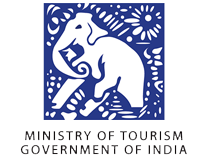

Contact Us
 GIO Adventures Pvt. Ltd
GIO Adventures Pvt. LtdDehradun - Uttarakhand
- +91-7895979211
- info@gio.in

